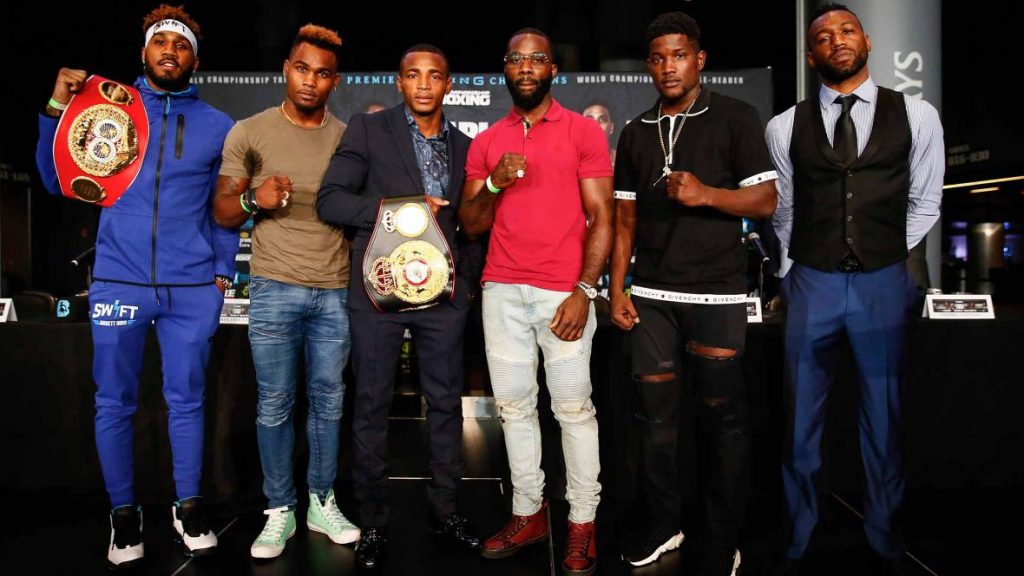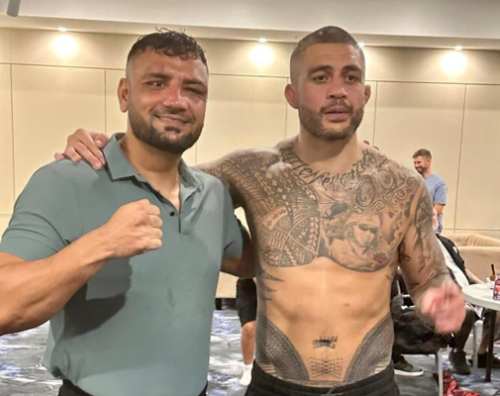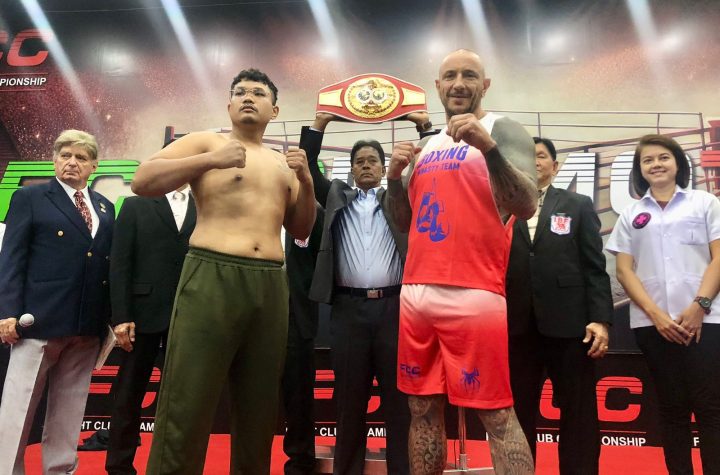
Premierboxingchampions.com
Six of the world’s top 154-pound boxers are ready to pay homage to their division’s deep history, while trying to strengthen their own legacies Saturday night during a title tripleheader in Brooklyn, NY.
A 154-pound title tripleheader airs this Saturday, Oct. 14 on Showtime at 10 p.m ET/7 p.m. PT.
It’s a weight class that holds a list of greats, all-time greats and transcendent greats: Nino Benvenuti, Manny Pacquiao, Wilfred Benítez, Roy Jones Jr., Sugar Ray Leonard, Miguel Cotto, Thomas Hearns, Mike McCallum, Julian Jackson, Roberto Durán, Terry Norris, Tommy Hearns, Floyd Mayweather Jr., and Winky Wright.
Almost all of them are Hall of Famers or will be Hall of Famers. Yet, if you asked most boxing experts what weight class most of the above fighters are associated with, not many would say 154 pounds. Although, every fighter listed fought and held titles in that weight class.
Throughout the history of boxing, junior middleweight, or super welterweight, whatever moniker you prefer, has sometimes held the status of the ugly redheaded stepchild that has been the conduit connecting two great historic divisions—the welterweight class and middleweight division.
On Saturday night at the Barclays Center in Brooklyn, the current crop of world-class 154-pounders clash with titles at stake as WBA world chamion Erislandy Lara (24-2-2, 14 KOs) meets 2012 U.S. Olympian Terrell Gausha (20-0, 9 KOs) in the main event of a 154-pound title tripleheader airing on Showtime at 10 p.m. ET/7 p.m. PT. The other championship bouts feature WBC champion Jermell Charlo (29-0, 14 KOs) vs WBC No. 1 contender Erickson Lubin (18-0, 13 KOs) and IBF titleholder Jarrett Hurd (20-0, 14 KOs) facing former 154-pound champ Austin Trout (30-3, 17 KOs).
Through time, the division has received a modicum of respect. Maybe this group can change that, because there isn’t really a deep history at 154.
By most accounts, the division was created by the Austrian Board of Control so Emil Griffith could fight—and defeat—Teddy Wright on October 17, 1962, in Vienna, Austria. It was on a Wednesday. And to show how nebulous the division’s history began, some accounts go back to the early 1920s as to the establishment of the 154-pound class.
Another account has the division making its legitimate debut on October 20, 1962, three days after the Griffith-Wright “world” junior middleweight title bout that was sanctioned in Austria. A sanctioning body approved of the Denny Moyer-Joey Giambra fight, won by Moyer in the Portland Coliseum. Sonny Liston was the referee.
BoxRec.com has the weight class being established in 1952.
So even the history of the 152-pound division gets greeted with some lack of respect.
The division’s longest streak of consecutive title defenses belongs to a middling Italian named Gianfranco Rosi, who defended his title a record 11 times—before meeting a real title holder in Donald Curry in 1988.
“The strongest historic time for the junior middleweight division was in the 1980s, and no offense to Gianfranco Rosi, he’s the one who’s made the most defenses as a junior middleweight champion,” said Showtime boxing broadcaster, noted boxing historian and Hall of Famer Steve Farhood. “Rossi was a good fighter, but he wasn’t Bernard Hopkins at middleweight, Bob Foster at light heavyweight and Roberto Duran at lightweight.
“Today’s junior middleweight class isn’t as strong as the division was in the 1980s, when you had the four kings (Leonard, Duran, Hagler and Hearns) hovering around 152, but is growing and has something to aspire to. I break down the division today into three categories. You have the veterans, which is obviously Lara and Trout, the other is the young stars, which is Jermell and Demetrius Andrade, who could move to middleweight, and then the younger guys, like Lubin, who could be a future champion.
“It’s a good mix of today, tomorrow and yesterday.”
“ Today’s junior middleweight class isn’t as strong as the division was in the 1980s, when you had the four kings (Leonard, Duran, Hagler and Hearns) hovering around 152, but is growing and has something to aspire to. ”Showtime boxing broadcaster and historian Steve Farhood
Farhood addressed the history of why junior middleweight has been sometimes viewed as a way station between welterweight and middleweight.
“Fighters go where the money is, and it’s like cruiserweight, the money has historically been at light heavyweight and heavyweight,” Farhood said. “Money has been at middleweight, and its why Ray Leonard moved up, and why Mike McCallum moved to 160. Historically, the money has always been at middleweight.
“Junior middleweight is not a division unlike any other weight class. Would Aaron Pryor not be Aaron Pryor if he fought at any other weight class than 140? I don’t know. The division is certainly capable of producing outstanding champions.”
John David Jackson held titles at 154 and at 160. Now a highly successful trainer, Jackson recalls how the division was viewed, and in the past how it was overlooked. Jackson ruled when Julian Jackson, Vincent Pettway, Rosi, Terry Norris, Curry and Vinny Pazienza came through there.
“There were a lot of great fighters at 154, and it is a division that doesn’t get the respect that it’s due, because it is in the shadow of the glamour division, which is the middleweight class,” Jackson said. “The weight was easy for me to make. I was a natural 154-pounder. But I had been a junior middleweight since I was 17 and it’s a weight class that you can grow out of.
“Today, there is also talent there. Like when I fought, it is a division that gets overlooked because of the middleweight division, which is obviously where you have Canelo Alvarez and Gennady Golovkin. In my era, in the late-1980 and early-1990s, the top junior middleweights weren’t allowed to fight each other. Imagine how many great fights would have been made if the best were allowed to fight the best back then. I was turned down 35 times for a fight—and it was a title fight.”
One time, Jackson recalled, sitting in the office of a prominent promoter when six calls were made to the managers of six contenders. They all said ‘no.’
Julian Jackson was one of the most terrorizing punchers of his time. Most of his most prominent victories came at 154.
“I started at welterweight but I moved up to 154,” Julian Jackson said. “A lot of people were looking at the heavyweight division, and that was Mike Tyson’s time, but I think we have among the best fighters in the world at 154 today. Boxing back then was more about the sport than it was about the money, I think. We had more love of the sport than you have today.
“I loved 154 and was comfortable there. It was a division filled with quick, powerful guys and that’s what makes the division unique.”
For a complete look at Lara vs Gausha, Charlo vs Lubin, and Hurd vs Trout, visit our fight page.

Top 154-pound fighters (left to right) Jarrett Hurd, Jermell Charlo, Erislandy Lara, Terrell Gausha, Erickson Lubin and Austin Trout pose during the introductory press conference for their Oct. 14 title tripleheader on Showtime. (Stephanie Trapp/Showtime)





More News
IBF Asia Heavyweight Title Fight: Bisutti vs. Nattapong
Liu Gang, Brico Santig Join Forces
Highland’s Double Impact: August 18 at Lumpinee